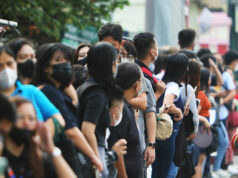FROM THE ARCHIVES: Boracay resorts face endless problems (1998)
[BusinessWorld, The Provinces, June 19, 1998]
By Eduardo L. Jalbuna
ILOILO CITY – The famed island of Boracay may have survived the coliform contamination controversy last year, but the nearly year-old financial crisis buffeting Asia-Pacific economies is adversely affecting resorts’s drive to transform the island into a prime tourist destination in Asia.
Boracay island off the northern coast of Panay island which started as a haven of backpackers in the early 1980s now boasts several major tourist facilities.
The coliform contamination controversy in June last year exposed the repercussions of unbridled, poorly planned development and almost brought the tourism industry on the island to a standstill.
But Region 6 Tourism director Edwin Trompeta claimed in a recent interview with BusinessWorld Boracay had been able to overcome the negative publicity this controversy spawned.
He said that while his office had projected “a six-month to one-year impact” from the controversy, it attributes the continuing below-standard tourist arrivals more to the financial crisis that has been hitting the region since July last year.
“The decrease in tourists is mainly due to the financial crisis,” he claimed.
He added the raging region-wide crisis is making Boracay resorts less competitive.
Boracay had begun attracting tourists from South Korea, Hong Kong and Taiwan in the early 1990s.
He recalled that, before the crisis, the island’s resorts had been recording as many as 250 Koreans at any given day who usually stayed for three nights and spent an average of P2,500 a day.
Beginning the second semester of last year, however, tourist arrivals from South Korea had dropped by more than 90%, Mr. Trompeta lamented.
On the whole, tourist arrivals in the first five months of this year numbered 84,032.
This represented a decline of about 14.8% from the 98,650 arrivals registered in the corresponding period last year, roughly on the eve of the regional crisis.
Mr. Trompeta noted the decline in arrivals of South Koreans was notable.
RECOMMENDED:
FROM THE ARCHIVES: Boracay resorts brace for less tourist arrivals (1997)
FROM THE ARCHIVES: Resorts lost P6.5M due to Boracay row (1997)
FROM THE ARCHIVES: Boracay developers not worried over contamination controversy (1997)
From January to May this year, there were only 1,088 South Koreans who visited the island, compared with 14,662 who visited during the corresponding period last year. hardest hit
South Korea, Thailand and Indonesia have been the hardest hit in the crisis and have required bailout arrangements from the International Monetary Fund.
And while Taiwan has been unaffected, Hong Kong officials fear recession may strike within the year.
Arrival of Japanese tourists on the island during the first five months of this year similarly dropped to 1,402 from 2,234 during the corresponding period last year, Mr. Trompeta noted further.
If it were not from the increase in arrivals of German, American, Australian and local tourists, resorts on the island could have been battered severely, he added.
The number of local tourists who visited Boracay during the comparative 1997-1998 periods actually increased to 62,225 from 57,607.
POOR PROSPECTS
Thus, prospects for increased tourist arrivals from neighboring East Asian countries remain uncertain amid continuing yen troubles and the probability of a devaluation of Beijing’s yuan by early next year at the latest.
Analysts are bracing for the latter, which is expected to trigger another round of devaluations of similar magnitude to the one which hit the region at the beginning of the crisis in July last year.
Mr. Trompeta said the crisis bared the propensity of Filipino resort operators to manage their businesses in an almost myopic way.
This, he said, is especially evident from their continuing tendency to jack up prices during the peak season in the first and second quarters that are not commensurate to the quality of amenities and services offered.
He noted further that operators, particularly those who rely on walk-in clients, have the mindset that tourists will be forced to accept any rate since they have few choices.
Mr. Trompeta said this is the root of many tourists’s disappointment with some establishments on the island.
He said his office has received numerous reports and complaints from both local and foreign tourists that they did not receive the quality of service they had paid for.
Moreover, resorts in Thailand and other Southeast Asian countries have been quoting their rates in local currencies.
In comparison, those on Boracay still quote in dollars.
He noted some of these establishments charge many times over better-equipped resorts in Thailand and Indonesia.
This, Mr. Trompeta fears, may doom Boracay resorts to uncompetitiveness in comparison with other resorts in neighboring countries.
COMPLANCENCY
“We have been telling resort operators on that island that Boracay is not the only destination in Asia,” Mr. Trompeta stressed.
“They are pricing themselves out of the market and are dragging down the entire tourism program of the country,” he rued.
He warned complacent resort owners had better wake up, since they will likely experience a serious slump this year.
Tourist arrivals had increased to 164,429 in 1996 from 29,551 in 1987.
In 1987, percentage of foreign tourists to total arrivals was only about 38.17%, but this increased to 44.56% in 1996.
Except for the coup-plagued years of 1986 to 1987, tourist arrivals on the island had always increased by double-digit rates.
In the first semester of last year, total tourist arrivals was at 109,088.
This reflected an 18.43% hike from the 1996 level.
Now, Mr. Trompeta fears actual tourist arrivals for the first semester this year – the traditional peak season — will most likely fail to reach the level recorded in the first semester of last year.
“The peak season is already over and there was a decline,” he noted.
“Nothing is in the off-season which can increase the tourist arrivals,” he said.



